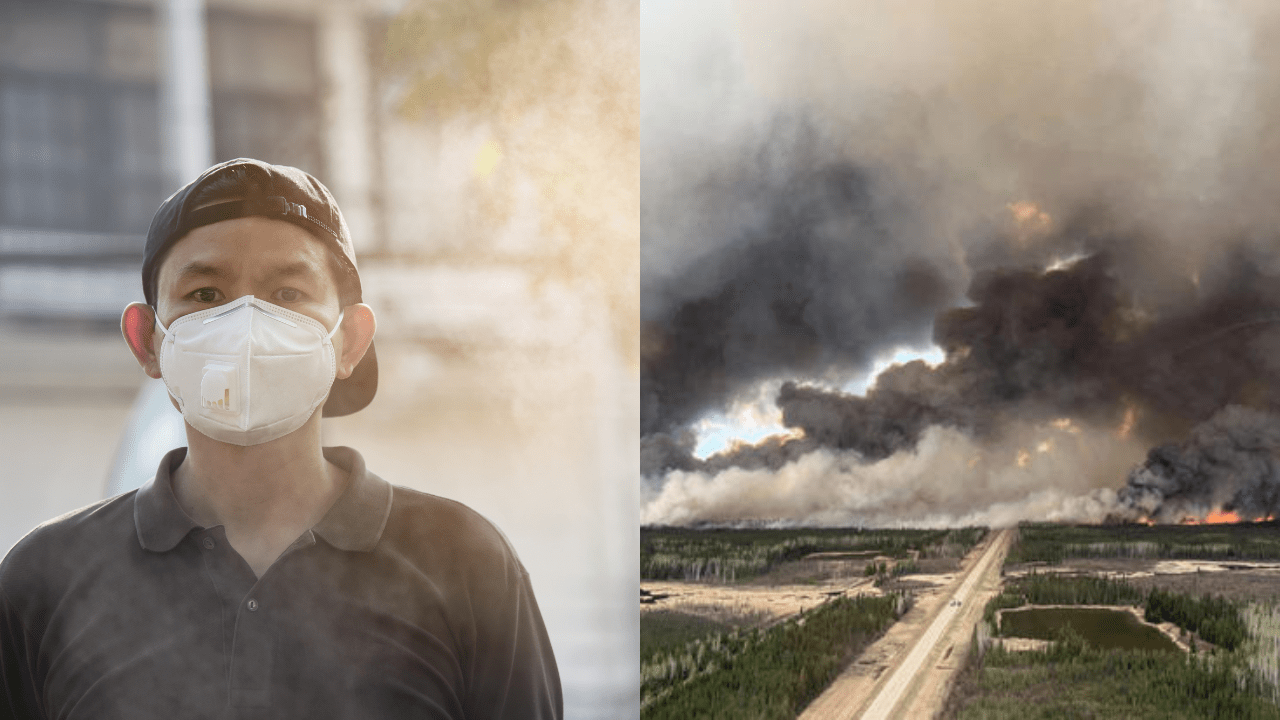Canada Wildfires Crisis Reaches US Shores, Triggering Minnesota’s First Air Quality Alert of 2024!

Minnesota has issued its first air quality advisory of 2024 because of thick wildfire smoke that has moved into the country from more than 100 active fires in Canada. With several fires deemed “out of control,” most concentrated in British Columbia and Alberta, the smoke has affected states from Montana to Wisconsin, with Minnesota experiencing particularly hazardous conditions.
Smoke plumes from more than 100 active wildfires in Canada have drifted south, shrouding a number of US states in haze and forcing authorities to declare Minnesota’s earliest air quality advisory of the year on Sunday.
An increasing percentage of the 140 wildfires in Canada, roughly 40 of them, have been declared “out of control,” as per the to authorities, raising fears about confinement. Ninety-one percent of these fires are located in the territories of Alberta as well as British Columbia. Canada’s wildfire season typically runs from May through October, a period when the country’s vast forests are vulnerable to outbreaks of fire. With approximately 9% of the world’s forests within its borders, Canada faces significant challenges in managing and mitigating wildfire risks.
In 2023, Canada experienced an unprecedented surge in wildfires, setting records for the number of blazes and the extent of their impact. The wildfires not only engulfed vast swathes of forested areas but also unleashed thick plumes of smoke that spread across borders, affecting air quality and prompting evacuations in British Columbia. The scale of the wildfires was such that it led to choking smoke in parts of the United States, forcing tens of thousands of people to flee their homes.
Canada Wildfires Smoke Blankets US, Prompting Minnesota’s First Air Quality Alert of 2024
The toll of the 2023 wildfires was not only environmental but also economic, with severe weather conditions causing over $3.1 billion in insured damages, as reported by officials. The destruction wreaked by the wildfires served as a stark reminder of the urgent need for effective wildfire management strategies and heightened preparedness measures to mitigate future risks.
Such wildfire’ effects have spread beyond the border, especially affecting the states of Montana and Wisconsin. But Minnesota is right in the heart of it, dealing with high levels of smoke on Sunday that led to the state issuing its first air quality warning in 2024.
The quality of the air in northern Minnesota is currently classified as “harmful” and has occasionally even slipped into the “very hazardous” category, with Air Quality Index (AQI) readings fluctuating between 150 to in excess of 200. With a worrying AQI of 212, the city of Bemidji in northern Minnesota is among the places with the poorest air quality in the world. The seriousness of the issue was highlighted by reports from locals that they could smell smoke in the air.
Authorities are warning citizens of the Minneapolis air quality, especially those who have allergies, to continue keeping their windows closed overnight as they prepare for moderate to substantial smoke levels as the night wears on. By dawn on Monday, the intensity of the wildfire smoke is expected to diminish significantly, with medium levels extending from Wisconsin to southern Minnesota.
Nevertheless, the effects of the smoke from wildfires are not limited to Minnesota. As the smoke keeps advancing, Omaha, Nebraska, is expected to see hazier skies by evening on Monday.
These incidents highlight the growing worries about the health risks associated with smoke from wildfires throughout the US. According to a report published in February, things are about to become worse. The First Street Foundation estimates that by the middle of the century, exposure to wildfire smoke could pose serious health concerns to approximately 125 million Americans.
North America has previously experienced the aftereffects of Canadian wildfires. Similar fires produced smoke that covered portions of the Northeast and Midwest in June 2023, resulting in 18 states issuing air quality concerns. Particularly, New York City was ranked first on the list of places with the worst air quality worldwide.
Everybody is affected by the well-established negative health impacts of smoke from wildfires, but those who already have medical issues are more vulnerable. Exposure to smoke from wildfires has been related by the Environmental Protection Agency (EPA) to lung cancer, heart disease, strokes, respiratory problems, and early mortality.
Related FAQs
The AQI is a standardized way to measure and communicate air quality to the public. It is calculated based on the concentrations of major air pollutants such as ground-level ozone, particulate matter (PM2.5 and PM10), carbon monoxide (CO), sulfur dioxide (SO2), and nitrogen dioxide (NO2). Each pollutant has its own AQI scale, and the overall AQI is determined by the highest value among these pollutants. AQI values range from 0 to 500, with lower values indicating better air quality and higher values indicating poorer air quality.
Poor air quality can have significant impacts on respiratory health. Exposure to high levels of pollutants like PM2.5 and ozone can exacerbate asthma, trigger respiratory symptoms such as coughing and shortness of breath, and increase the risk of respiratory infections. Long-term exposure to air pollution has also been linked to the development of chronic respiratory diseases like chronic obstructive pulmonary disease (COPD) and can contribute to cardiovascular problems such as heart attacks and strokes.
There are several steps individuals can take to protect themselves from the effects of poor air quality. These include:
- Monitoring local air quality reports and forecasts to stay informed about pollution levels.
- Limiting outdoor activities, especially during times when air quality is poor, such as on days with high AQI values or during periods of heavy traffic or industrial activity.
- Using indoor air purifiers with HEPA filters to reduce indoor air pollution.
- Wearing masks designed to filter out pollutants when outdoor air quality is particularly bad, especially for vulnerable populations such as children, the elderly, and individuals with respiratory conditions.
Also Read:

The Psychology of Love: Why Valentines Day Matters More Epic Than You Think
Discover the psychology of love and why Valentines Day is more important than you think. Learn how love impacts the brain, strengthens relationships, and boosts

Premier League Highlights: Arsenal Humiliate Man City 5-1, Spurs and Palace Secure Crucial Wins
Arsenal demolished Manchester City 5-1 in a statement premier league highlights win, reigniting their title hopes. Meanwhile, Crystal Palace stunned Man United 2-0, and Tottenham

How Budget 2025 Impacts the Indian Middle-Class: Major Tax Benefits and Glaring Omissions
Budget 2025 offers major tax relief to the middle class, including zero tax on incomes up to ₹12 lakh. However, it misses out on incentives

Degrees vs Employability: Why “Highly Qualified Degree Holders” Struggle to Find Jobs While “Less Qualified Individuals” Get Hired Faster!
Many highly qualified individuals struggle to secure jobs, while less qualified candidates get hired quickly. This Degrees vs Employability paradox is caused by employer preferences,

The Power of Mindset: Why Looking Poor Doesn’t Make You Poor, but Thinking Poor Does!
Discover why looking poor doesn’t define your wealth but thinking poor does. Learn the power of mindset and how a growth-oriented mindset can lead to

Overthinking: How It’s Damaging Today’s Youth – Causes and Cure in 2025
Understanding how overthinking is silently damaging today’s youth, from its causes rooted in societal pressure and social media to its long-term effects on mental health.
